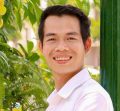Seven selected calligraphies for an encounter between two artforms and two men: German poetry meets Vietnamese art, represented by 18th-century poet Heinrich Heine and 21st-century artist Ngẫu Thư.
Opening of the exhibition | 26.08. 2019, 6 PM
Heinrich Heine’s “Lyrical Intermezzo”, translated by Chu Thu Phuong, is one of calligrapher Ngẫu Thư’s sources of inspiration in his long record of working with language art. The artist selected seven poems from Heine’s cycle, breathing new life into the old verses. In his calligraphy, Ngẫu Thư literally spelled out Heine’s highly pictorial, metaphorical language, visually rendering its emotional tensions.
Between 1822 and 1823, Heine immortalized love as a perpetual theme and as a constant back and forth between its two conflicting states of joy and sorrow as fundamental experiences that make life worth living. In 2019, Ngẫu Thư pays tribute to these works in his calligraphy, using traditional papers such as “Dó” and “Xuyến”, combined with Chinese ink and special varnish as well as variations in verse breaks and rhythms.
Ngẫu Thư enriches and pays homage to Heine’s poetry by injecting his own personal perspectives. His calligraphies are a synthesis of great cultural density: Ngẫu Thư dedicates his art both to one of Germany’s foremost poets and a centuries-old Vietnamese craft.
 © Nguyen Thanh Tung
© Nguyen Thanh Tung
Ngẫu Thư’s full name is Nguyễn Thanh Tùng. The Hanoi-based artist has been working with calligraphy since he was a young teenager. In 2006, he began to study calligraphy in Ho Chi Minh City. He graduated from the Faculty of Literature at the Ho Chi Minh City University of Education in 2010. Driven by his continued devotion, passion, gratitude, and appreciation for quintessential national traditions, Ngẫu Thư decided to study calligraphy so he could design and preserve it for modern everyday life, molding the spiritual values of Vietnam’s “infinitely ancient” ancestors into a new form.
Back